About 1.7 million different types of living things or organisms that live on Earth have been identified and described. It is easier to find products in a supermarket when they are grouped, and in a similar way it’s easier to describe and talk about all the living things on Earth if they are sorted into groups. Taxonomists classify organisms into groups by using the characteristics they have in common. One group you probably already know something about is the animal kingdom.
Kingdom
The first level of classification sorts living things into a small number of groups. Each group has a very large number of organisms in it, and each organism shares important characteristics with others in their group. Although similar in many ways, the organisms in each group still have many, many differences. Kingdom is the name given to the group at this first level of classification.
Taxonomists have sorted all living things into five kingdoms. One kingdom is the animal kingdom. You could probably produce a long list of animals that would include kangaroos, rosellas and snakes. However, bees, worms and jellyfish are animals too.
Animal phyla
-
Animals are often described as vertebrates (animals with backbones)
-
Invertebrates (animals without a backbone)

Poriferans
• Poriferans are commonly called sponges.
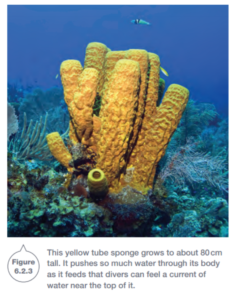
Cnidarians
- Jellyfish, sea anemones and coral polyps belong to cnidarians.
- They have radial symmetry and only one body opening. Food goes into the body through this opening and waste comes out of the same opening.
- Cnidarians have stinging cells, which they use to catch food. Cnidarians are not interested in using humans for food, but the poison from their stinging cells will cause you intense pain.
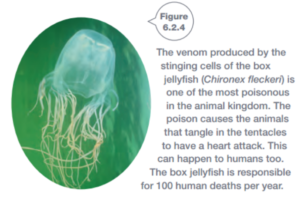
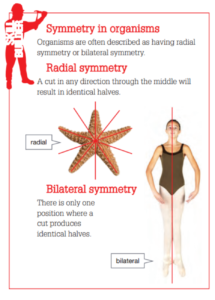
Echinoderms
- Starfish, brittlestars, sea urchins and sea cucumbers belong to the echinoderms.
- They all live in the ocean, often near the coast. Starfish, brittlestars and sea urchins have a spiny skin, which you can see in Figure 6.2.5, but the skin of sea cucumbers is leathery.
Activity
Find the meanings of the following words:
- detritus – rock in small particles or other material worn of broken away from mass
- radial symmetry – a basic body plan in which the organism can be divided into similar halves.
- ocean abyss – a bottomless pit
- benthic zone – a benthic zone is the lowest level of a marine or a fresh water system.
- bioturbation – Bioturbation is a transport of sediment particles. For example in muddy sediments, bioturbation appears to reduce densities.
- symbiotic relationship – when two organisms work together with one function
- commensalism – a relationship between two organisms where one benefits and the other one doesn’t benefit.
Research activity
- What are crown of thorns star fish?
crown of thorns starfish is a large spiky starfish, and sometimes causes damage to the reefs.
- What do they eat?
The crown of thorns starfish eat coral, it prefers growing hard corals.
- Where do they live? Crown of thorns starfish live in reefs throughout the Indo- Pacific region.
- Why is the crown of thorns star fish so bad? The crown of thorns starfish is bad because it causes massive damages to the reefs in the Indo – Pacific region
- What are people doing about the problem The professional divers are injecting the starfish with bile salt. Bite salt is used to kill the starfish.
Annelids
- The most familiar annelid is the earthworm.
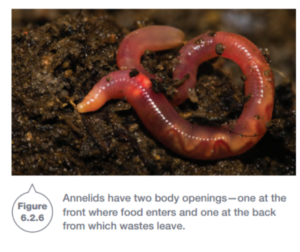
Nematodes
Nematodes are ’roundworms’. They have bilateral symmetry like annelids, with long tapered bodies that are pointed at each end, but they do not have segments. They are commonly found in damp soil, in water, and as parasites in the bodies of other organisms. Parasites are organisms that live on or in another organism, called a host. They get their food from the host, but the host gets nothing in return and may be harmed. Heart worm, a common disease of dogs, is caused by a nematode.
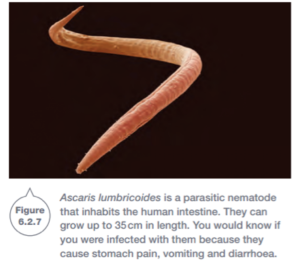
Platyhelmiths
Platyhelminths are flatworms. They have bilateral symmetry with the body flattened top to bottom.
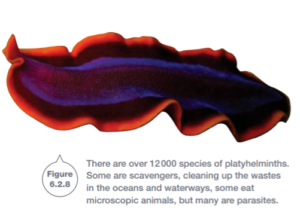
Molluscs
Molluscs are members of the second largest phylum in the animal kingdom. Snails, slugs, oysters and mussels belong to this group. All of them live in water or in very moist places.They come in a wide variety of shapes and sizes, but all have bilateral symmetry, have well developed internal organs, and have a muscular foot which they can use to move along.

Arthropods
Arthropods form the largest animal phylum, with over one million species described. The phylum include :
- insects
- scorpions and spiders
- Crustaceans like prawns, crabs, lobsters and Balmain bugs
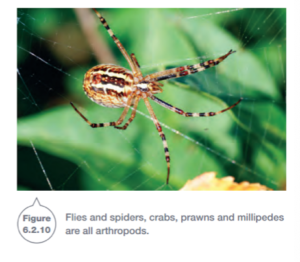
Arthropods are found everywhere- on land, in the air and in water. They are able to survive on dry land because they have a waterproof exoskeleton -a skeleton on the outside of the body. The skeleton does not bend, so the limbs of arthropods (legs and antennae) are jointed to allow the animals to move. Inside, the body is divided into segments. These are sometimes visible as lines across the exoskeleton.
Chordates
Most of the larger animals you see around you can be described as vertebrates. Dogs, cows, birds, fish and humans are all vertebrates. All vertebrates belong to the same phylum, the chordates.
Chordates have a nerve cord running down their backs, which gives this group its name. Most chordates have skeletons inside their body (an endoskeleton), and most of the chordates have a series of small bones protecting the nerve cord. The small bones are called vertebrae, and together they are called the vertebral column or backbone. The group of chordates that has a backbone is commonly called the vertebrates.
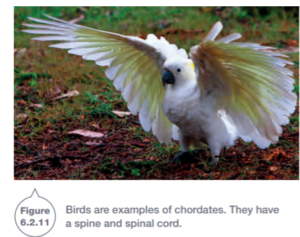
All chordates have bilateral symmetry. They are divided into classes based on a range of characteristics that includes the way they breathe, their skin covering, body temperature, and how they reproduce.

There are three classes of chordates that are commonly called fish: Agnatha, Chondrichthyes and Osteichthyes. They all live in water and breathe using gills. They are ectothermic, which means that their body temperature varies with the temperature of the water they live in.
Agnatha
The agnatha are jawless fish. There are many fossils of jawless fish. They have an internal skeleton made of cartilage. This is more flexible than bone- it is cartilage in the wobbly bit at the end ofyour nose. Agnatha have a fin along their backs. Their mouth is a round sucker, lined with horny teeth, which they use to attach themselves to other fish. All agnatha are parasites.
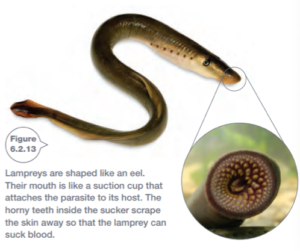
Chondrichthyes
Sharks and rays belong to the class of chordates called chondrichthyes. Their skeleton is also made of cartilage, which gives them their common name of cartilaginous fish. Unlike the jawless fish, they have proper jaws and teeth. Sharks and rays have fins on the side of their bodies as well as along their backs.

Osteichthyes
The osteichthyes are bony fish. They have fins on the back and sides of their body and have proper jaws and teeth. What makes them different from the other fish is their skeleton made of bone. Tuna, goldfish, eels, sea horses and lungfish all belong to this group.
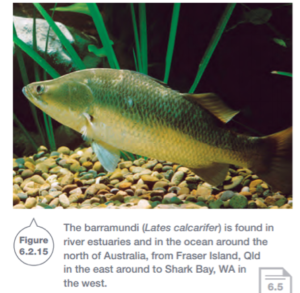
Amphibians
Frogs, like the one shown in Figure 6.2.16, toads, newts and salamanders are all amphibians. Amphibians are chordates that live both in and out of water. Their eggs ]are laid in water, and the larvae or tadpoles must live in water because they breathe through gills. The body then changes shape in a process called metamorphosis, allowing the adult to live on land, breathing air using lungs. Their lungs are not very effective, and amphibians also take in oxygen through their skin. To be able to do this their skin must remain moist.

Reptiles
Reptiles such as snakes (Figure 6.2.17), crocodiles and lizards are ectothermic, and have a dry, scaly skin. They breathe using only their lungs. Generally they lay eggs with a leathery shell on land.While most spend their whole life cycle on land, there are exceptions. Sea snakes spend all their lives in water, and some cannot move on land at all. Sea snakes do not Jay eggs; instead they give birth to live young. Some land snakes and lizards also do this.
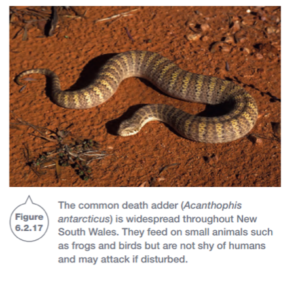
Aves
Aves is the biological name for birds. Birds are different from other groups because they have feathers covering their body and lay hard-shelled eggs. All birds have wings, including those that can’t fly, like the penguins in Figure 6.2.18. (Bats are the only other chordates with wings, but they are mammals.) Birds are endothermic, meaning that they generate their own heat and are able to control their body temperature. This allows them to remain warm in cold environments.

Mammals
The class Mammals includes all the animals that have a body covering of hair, and feed their babies on milk produced by the mother. Like birds, mammals are endothermic. Mammals are divided into three sub classes based on the way they reproduce. All three of these sub classes are represented by animals found in Australia.
-
Placentals are mammals that nourish the baby inside the mother’s body by a placenta and the baby is born
at a more mature stage. Placental mammals include seals, dingoes, horses, humans, humpback whales and flying foxes (Figure 6.2.19).
-
Monotremes Jay eggs; this subclass consists of two species of echidna (one species is shown in
Figure 6.2.20) and the platypus.
-
Marsupials such as a wombat gives birth to a tiny underdeveloped young that climbs into the pouch where it is fed on milk. The young marsupial grows and completes its development in the pouch.



